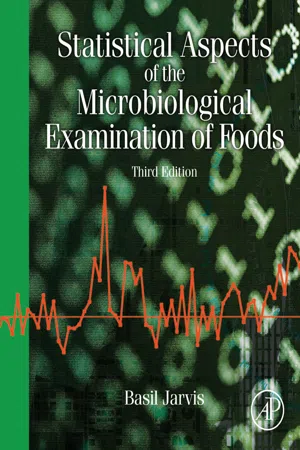
- 352 pages
- English
- ePUB (mobile friendly)
- Available on iOS & Android
Statistical Aspects of the Microbiological Examination of Foods
About this book
Statistical Aspects of the Microbiological Examination of Foods, Third Edition, updates some important statistical procedures following intensive collaborative work by many experts in microbiology and statistics, and corrects typographic and other errors present in the previous edition. Following a brief introduction to the subject, basic statistical concepts and procedures are described including both theoretical and actual frequency distributions that are associated with the occurrence of microorganisms in foods. This leads into a discussion of the methods for examination of foods and the sources of statistical and practical errors associated with the methods. Such errors are important in understanding the principles of measurement uncertainty as applied to microbiological data and the approaches to determination of uncertainty.The ways in which the concept of statistical process control developed many years ago to improve commercial manufacturing processes can be applied to microbiological examination in the laboratory. This is important in ensuring that laboratory results reflect, as precisely as possible, the microbiological status of manufactured products through the concept and practice of laboratory accreditation and proficiency testing. The use of properly validated standard methods of testing and the verification of 'in house' methods against internationally validated methods is of increasing importance in ensuring that laboratory results are meaningful in relation to development of and compliance with established microbiological criteria for foods.The final chapter of the book reviews the uses of such criteria in relation to the development of and compliance with food safety objectives. Throughout the book the theoretical concepts are illustrated in worked examples using real data obtained in the examination of foods and in research studies concerned with food safety.- Includes additional figures and tables together with many worked examples to illustrate the use of specific procedures in the analysis of data obtained in the microbiological examination of foods- Offers completely updated chapters and six new chapters- Brings the reader up to date and allows easy access to individual topics in one place- Corrects typographic and other errors present in the previous edition
Frequently asked questions
- Essential is ideal for learners and professionals who enjoy exploring a wide range of subjects. Access the Essential Library with 800,000+ trusted titles and best-sellers across business, personal growth, and the humanities. Includes unlimited reading time and Standard Read Aloud voice.
- Complete: Perfect for advanced learners and researchers needing full, unrestricted access. Unlock 1.4M+ books across hundreds of subjects, including academic and specialized titles. The Complete Plan also includes advanced features like Premium Read Aloud and Research Assistant.
Please note we cannot support devices running on iOS 13 and Android 7 or earlier. Learn more about using the app.
Information
Introduction
Abstract
Keywords
Some basic statistical concepts
Abstract
Keywords
Populations
Table of contents
- Cover
- Title page
- Table of Contents
- Copyright
- Preface to the Third Edition
- Chapter 1: Introduction
- Chapter 2: Some basic statistical concepts
- Chapter 3: Frequency distributions
- Chapter 4: The distribution of microorganisms in foods in relation to sampling
- Chapter 5: Statistical aspects of sampling for microbiological analysis
- Chapter 6: Errors associated with preparing samples for analysis
- Chapter 7: Errors associated with colony count procedures
- Chapter 8: Errors associated with quantal response methods
- Chapter 9: Statistical considerations of other methods in quantitative microbiology
- Chapter 10: Measurement uncertainty in microbiological analysis
- Chapter 11: Estimation of measurement uncertainty
- Chapter 12: Statistical process control using microbiological data
- Chapter 13: Validation of microbiological methods for food
- Chapter 14: Risk assessment and microbiological criteria for foods
- Subject Index